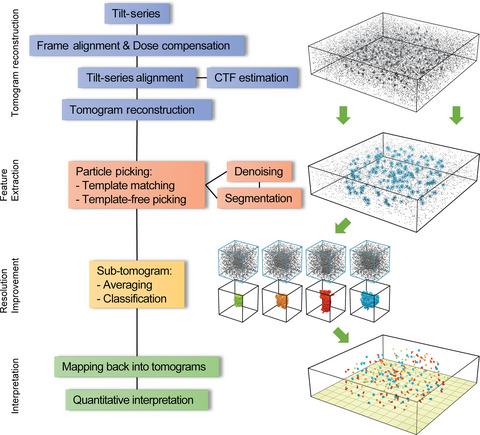当前位置:
X-MOL 学术
›
FEBS Lett.
›
论文详情
Our official English website, www.x-mol.net, welcomes your
feedback! (Note: you will need to create a separate account there.)
The Promise and the Challenges of Cryo‐Electron Tomography
FEBS Letters ( IF 3.0 ) Pub Date : 2020-10-01 , DOI: 10.1002/1873-3468.13948 Martin Turk 1 , Wolfgang Baumeister 1
FEBS Letters ( IF 3.0 ) Pub Date : 2020-10-01 , DOI: 10.1002/1873-3468.13948 Martin Turk 1 , Wolfgang Baumeister 1
Affiliation

|
Structural biologists have traditionally approached cellular complexity in a reductionist manner in which the cellular molecular components are fractionated and purified before being studied individually. This ‘divide and conquer’ approach has been highly successful. However, awareness has grown in recent years that biological functions can rarely be attributed to individual macromolecules. Most cellular functions arise from their concerted action, and there is thus a need for methods enabling structural studies performed in situ, ideally in unperturbed cellular environments. Cryo‐electron tomography (Cryo‐ET) combines the power of 3D molecular‐level imaging with the best structural preservation that is physically possible to achieve. Thus, it has a unique potential to reveal the supramolecular architecture or ‘molecular sociology’ of cells and to discover the unexpected. Here, we review state‐of‐the‐art Cryo‐ET workflows, provide examples of biological applications, and discuss what is needed to realize the full potential of Cryo‐ET.
中文翻译:

冷冻电子断层扫描的前景和挑战
结构生物学家传统上以还原论的方式处理细胞复杂性,其中细胞分子成分在单独研究之前被分离和纯化。这种“分而治之”的方法非常成功。然而,近年来人们越来越意识到生物功能很少可以归因于单个大分子。大多数细胞功能源于它们的协同作用,因此需要能够在原位进行结构研究的方法,理想情况下是在不受干扰的细胞环境中。冷冻电子断层扫描 (Cryo-ET) 将 3D 分子级成像的强大功能与物理上可能实现的最佳结构保存相结合。因此,它具有揭示细胞的超分子结构或“分子社会学”并发现意想不到的独特潜力。在这里,我们回顾了最先进的 Cryo-ET 工作流程,提供了生物应用示例,并讨论了实现 Cryo-ET 全部潜力所需的条件。
更新日期:2020-10-01
中文翻译:

冷冻电子断层扫描的前景和挑战
结构生物学家传统上以还原论的方式处理细胞复杂性,其中细胞分子成分在单独研究之前被分离和纯化。这种“分而治之”的方法非常成功。然而,近年来人们越来越意识到生物功能很少可以归因于单个大分子。大多数细胞功能源于它们的协同作用,因此需要能够在原位进行结构研究的方法,理想情况下是在不受干扰的细胞环境中。冷冻电子断层扫描 (Cryo-ET) 将 3D 分子级成像的强大功能与物理上可能实现的最佳结构保存相结合。因此,它具有揭示细胞的超分子结构或“分子社会学”并发现意想不到的独特潜力。在这里,我们回顾了最先进的 Cryo-ET 工作流程,提供了生物应用示例,并讨论了实现 Cryo-ET 全部潜力所需的条件。











































 京公网安备 11010802027423号
京公网安备 11010802027423号